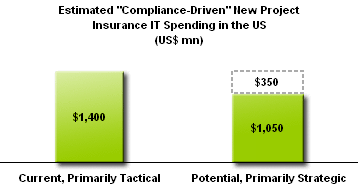The Virtuous Cycle of Compliance and IT?
Abstract
New York, NY, USA November 4, 2004 ?By shifting to a strategic, issue-based approach, Celent believes that insurers could reduce their compliance-related IT spending by as much as 25 percent, or more than US$350 million industry-wide.  The importance of regulatory compliance is at an all-time high for insurers and their IT departments. Between Sarbanes-Oxley, GLBA, HIPAA, USA PATRIOT Act, and various state regulations, Celent estimates that insurers are devoting an average of 20 percent of their new project IT budgets (or US$1.4 billion industry-wide) to compliance-mandated projects. In a new report, ?, Celentexamines the key compliance, IT, and business issues facing insurers and how they overlap. The report briefly highlights some compliance-driven IT projects that delivered broader business value. It concludes with key points for both insurers and solution providers. Insurers have had a tendency to approach compliance on a statute-by-statute basis, scrambling to meet the specific requirements of each new mandate without taking a holistic and strategic view of their common issues. Celent believes that by shifting compliance IT efforts from a reactionary, statute-based framework to a strategic, issue-based one, insurers can reduce the "compliance-mandated" component of their new project spending by at least a quarter. "Most compliance mandates involve a few key issues, which in turn map to four key IT areas: data and network security, data quality, operational and financial transparency, and record retention and accessibility," says Matthew Josefowicz, manager of Celent痴 insurance group and author of the report. "These are the same IT issues required for key business initiatives like improving cross-selling, pricing and underwriting ability, business intelligence and strategic planning, and multi-channel distribution."Celent痴 report recommends that insurers recognize the common ground between compliance IT issues and business IT issues, and understand that compliance and IT departments can be natural partners, not antagonists. By banding together, they can make a stronger case for badly needed infrastructure improvements that business is often hesitant to sponsor on its own, improving each department痴 efficiency while creating business value across the enterprise. The 20-page report contains five figures and four tables. A table of contents is available here. |
of Celent Communications' Property/Casualty Insurance and Life/Health Insurance research services can download the report electronically by clicking on the icon to the left. Non-members should contact info@celent.com for more information. |
|

